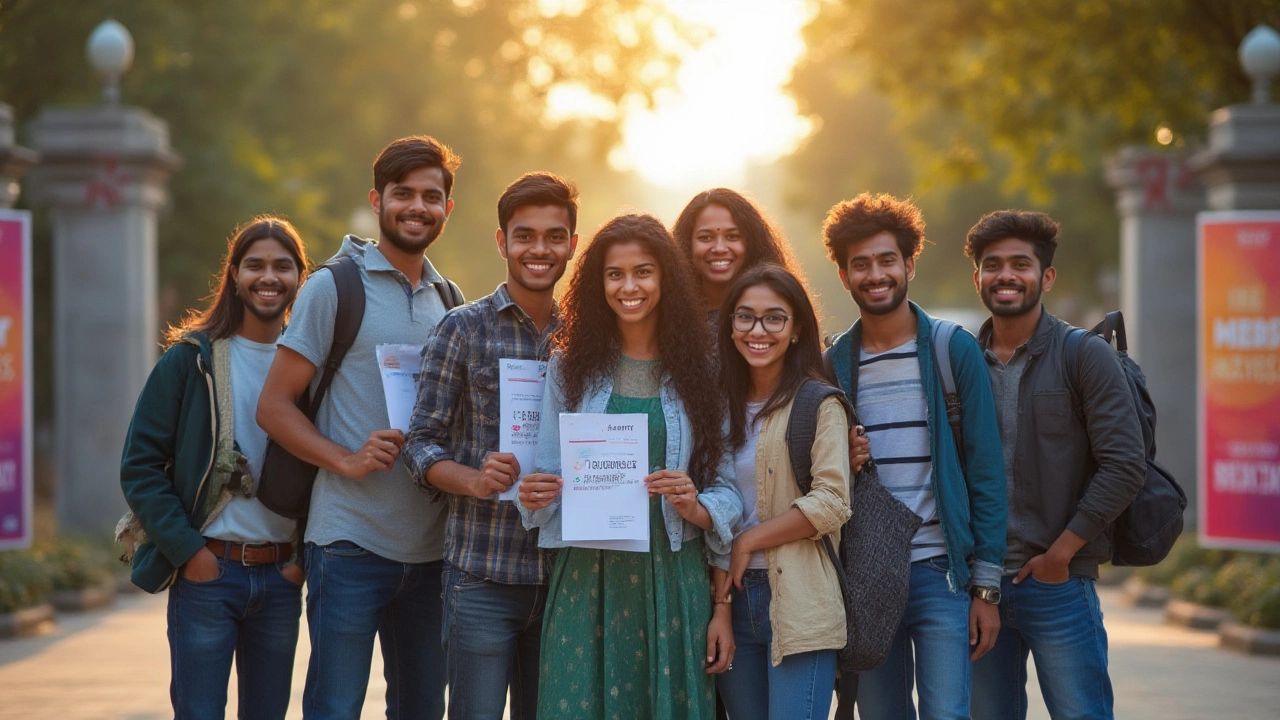Which Doctor is Best After NEET? Choosing the Right Medical Career Path in 2025
 Jul, 19 2025
Jul, 19 2025
Fresh out of the NEET exam hall, you’re buzzing with adrenaline and probably a dose of nerves. Smashed the cutoff or landed somewhere around it? Now comes the real question, the one everyone from your relatives to your own reflection keeps asking: which doctor is best after NEET? The twist? There’s no single answer. India’s medical field is massive—think MBBS, BDS, BAMS, BHMS, and surprise, a swarm of allied fields you may not even know exist. Gone are the days when only MBBS felt prestigious. With lakhs of students giving NEET each year, the need to choose wisely has never been sharper. Cracking NEET is just step one. Honing in on the best-fit path? That’s where things get interesting.
Understanding Your Medical Career Choices After NEET
When NEET results are out, MBBS usually hogs the spotlight. Why? It’s the classic route—Bachelor of Medicine, Bachelor of Surgery. The badge many wear with pride. The number of MBBS seats in India has grown a lot; there were about 109,145 MBBS seats in 706 medical colleges as of 2025, according to the National Medical Commission. Still, getting into a government college is tough—only about 20% of candidates end up with those dream seats. The rest face private college tuitions that often touch ₹50 lakhs for the course, not counting accommodation and living costs.
Here’s where things get interesting. BDS—the Bachelor of Dental Surgery—is more than just a backup. India actually churns out around 26,949 BDS graduates each year from 323 dental colleges. Dentistry’s appeal? Shorter course (five years total), easier work-life balance, solid job options in both private and government setups, and a rising demand for cosmetic and specialized dental care. Still, competition in cities can make setting up a successful private clinic a waiting game.
Love both ancient healing and science? Then BAMS—Bachelor of Ayurvedic Medicine and Surgery—brings a unique blend of modern clinical work and Ayurveda’s centuries-old wisdom. With India’s turn towards natural medicine, BAMS grads are finding cool spots on hospital teams, opening ayurvedic clinics, and working with international wellness brands. About 68,000 BAMS seats are offered annually now. Then there’s BHMS (homeopathy), BUMS (unani medicine), and even BPT (physiotherapy). Here’s what you don’t hear enough: each field has top performers earning a killing, and others grinding slowly. It’s less about the course, and more—way more—about your drive and interests.
| Course | Number of Seats (2025) | Duration | Approximate Tuition Fees (₹, Govt/Private) |
|---|---|---|---|
| MBBS | 109,145 | 5.5 years | 1-2 lakhs/yr (Govt); 10-22 lakhs/yr (Private) |
| BDS | 26,949 | 5 years | 85000-1.5 lakhs/yr (Govt); 4-10 lakhs/yr (Private) |
| BAMS | 68,000 | 5.5 years | 60,000-2 lakhs/yr (Govt); 3-8 lakhs/yr (Private) |
| BHMS | 14,000 | 5.5 years | 55,000-1 lakh/yr (Govt); 2-6 lakhs/yr (Private) |
| BPT | 12,000 | 4.5-5 years | 50,000-1.5 lakhs/yr (Govt); 3-5 lakhs/yr (Private) |
If you’re aiming for government jobs, the safest bets are MBBS and BDS, but BAMS and BHMS are catching up with growing government hospital posts and AYUSH ministry schemes. Feeling adventurous? Paramedical degrees—like BSc Nursing, Radiology, Medical Laboratory Technology, or Optometry—offer quick entry into hospitals and diagnostic labs with solid earning potential, especially abroad. In 2025, Australia and the Middle East need thousands of Indian nurses and allied health grads—check the numbers: Over 15% of Indian BSc Nursing graduates from 2023 landed jobs overseas last year.
MBBS or Beyond: Should You Go for the “Classic” Medical Route?
Everyone’s heard stories about toppers fighting for a few thousand MBBS government seats, and it’s true. But ask any first-year medical student: life in an MBBS college is no cakewalk. The learning curve is steep; it’s six-day weeks, endless books, constant exams, and rotations. After 5.5 grueling years (including one internship year), most MBBS graduates aren’t done—they prep for NEET-PG, fight for a residency, or take up rural postings. The medical student suicide rate, according to a 2023 study by the Indian Psychiatric Society, was 12 per 100,000, highlighting the mental-health load. If your heart isn’t fully in, that grind can wear you thin.
Yet, MBBS still rules if you’re chasing long-term options, government jobs, teaching, or super-specializations (think Cardiology, Neurology, Pediatrics, Surgery). You want to wear a stethoscope, lead a surgical team, and tackle emergencies? This is the path. The salary isn’t instant. Fresh MBBS doctors in most Indian states start around ₹50,000-70,000 monthly, and that jumps dramatically with specialization and private practice. Senior consultants in private hospitals sometimes cross ₹5 lakhs a month, but competition is brutal and reputation is everything.
If you’re open to international routes, an MBBS from India lets you appear for exams like USMLE (for USA), PLAB (UK), and AMC (Australia). Not everyone cracks these, but those who do usually secure higher pay and better work conditions. If you plan to move overseas, check recognition of your Indian medical degree—NMC-approved colleges boost your credibility.
Don’t forget, MBBS is versatile. Medical journalism, health administration, clinical research, and hospital management often need the expertise of an MBBS or BDS grad. Those who love teamwork, patient interaction, and the science behind medicine still find the MBBS grind worth it—but only if it lines up with their personality and life goals.

Alternative Medical Careers: Are BDS, BAMS, or BHMS Right for You?
best doctor after NEET isn’t always an MBBS—this is where things get surprisingly wide open. If you secretly love teeth, aesthetics, and fine motor work, BDS can be your calling. Dentists are in demand both for everyday oral care and for cosmetic procedures like implants, veneers, and smile design. The average established private dentist in metros can pull in ₹1.5-4 lakhs per month, but setting up your client base does take patience. In smaller cities, dentist-to-patient ratios are much healthier, meaning more patients but slightly lower rates. The point is, dentistry is no “easier cousin” of medicine—it comes with its own expertise and prestige.
Then there’s traditional medicine. BAMS (Ayurveda), BHMS (Homeopathy), and BUMS (Unani) tap into India’s deep roots. These aren’t just backups—they’re sought-after professions, especially as millions trust these systems for chronic and lifestyle diseases. Ayurveda clinics, wellness resorts, and online consultancies took off after the pandemic. If you have a knack for alternative healing and patient counseling, you’ll love these paths. Not just that—AYUSH recruitment is on the rise, and private wellness chains are hungry for skilled grads.
Physiotherapy and Occupational Therapy are the real MVPs for students interested in rehabilitation, sports medicine, or post-injury care. BPT grads work in hospitals, sports clubs, fitness startups, and do independent practice. In metros, an experienced physiotherapist easily earns ₹40,000 to ₹2 lakhs monthly, especially with home care and working with athletes.
If quick jobs and migration abroad are your priority, look into BSc Nursing or Paramedical courses. These demand fewer years, focus on hands-on hospital roles, and boast great unemployment rates. Australia, Canada, the UK—all keep opening their doors for trained Indian nurses, lab techs, and radiographers. The World Health Organization says India needs 2.4 million more health workers by 2030—from nurses to X-ray techs, so this is a safe play for those wanting a stable and respected role, even outside the typical "doctor" title.
Making Your Decision: Smart Tips to Choose Your Medical Path After NEET
Pushed by family, friends, maybe even the neighborhood tuition teacher? Pause. Your own strengths and interests matter most here. If you faint at the sight of blood or can’t do night duties, MBBS might not be the best mental fit. If you crave patient rapport, continuity, or work-life balance, dentistry or physiotherapy could fit you better. Map your learning style, temperament, and big dreams first.
Next, weigh the financials. Government MBBS and BDS seats are gold. For private seats, add up hostel, food, books, and hidden costs—not just tuition. Not everyone wants to drop ₹1 crore on a private degree. Search scholarship options from states like Tamil Nadu, Maharashtra, and West Bengal, which often award rank-based scholarships even in private colleges.
Networking helps—a lot. Use LinkedIn, alumni groups, and senior students for inside info. Visit colleges during counselling, see the hostels, check labs yourself. Many doctors and dentists today host Instagram reels, YouTube Q&As, and even Clubhouse sessions—you’ll get real, unfiltered information about everyday life, not just brochure promises.
Finally, keep it real and flexible. If MBBS isn’t possible, don’t treat it like a do-or-die. Career paths in India today bend and shift—BDS grads work in research labs or even public health; BSc Nursing grads get hospital admin posts; BAMS doctors become wellness entrepreneurs or pharma leaders. In medical fields, perseverance, further specialization, and patient empathy matter more than the letters after your name. Remember, the best doctors aren’t always the ones with the highest ranks—they’re the ones who love what they do, keep learning, and help the most people on the way. Choose your path, learn everything you can, and walk it with confidence. That’s how you answer which doctor is best after NEET—in 2025 and beyond.